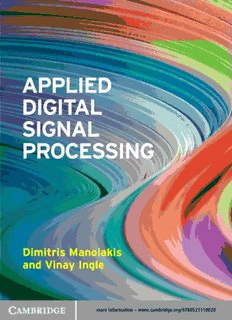Table Of ContentThis page intentionally left blank
Applied Digital Signal Processing
Masterthebasicconceptsandmethodologiesofdigitalsignalprocessingwiththissystem-
aticintroduction,withouttheneedforanextensivemathematicalbackground.Theauthors
leadthereaderthroughthefundamentalmathematicalprinciplesunderlyingtheoperation
of key signal processing techniques, providing simple arguments and cases rather than
detailed general proofs. Coverage of practical implementation, discussion of the limita-
tions of particular methods, and plentiful MATLAB illustrations allow readers to better
connect theory and practice. A focus on algorithms that are of theoretical importance or
usefulinreal-worldapplicationsensuresthatstudentscovermaterialrelevanttoengineer-
ingpractice,andequipsstudentsandpractitionersalikewiththebasicprinciplesnecessary
toapplyDSPtechniquestoavarietyofapplications. Chaptersincludeworkedexamples,
problems,andcomputerexperiments,helpingstudentstoabsorbthematerialtheyhavejust
read.Lectureslidesforallfiguresandsolutionstothenumerousproblemsareavailableto
instructors.
DimitrisG.ManolakisiscurrentlyaMemberofTechnicalStaffatMITLincolnLaboratory
in Lexington, Massachusetts. Prior to this he was a Principal Member of Research Staff
at Riverside Research Institute. Since receiving his Ph.D. in Electrical Engineering from
theUniversityofAthensin1981,hehastaughtatvariousinstitutionsincludingNortheast-
ernUniversity,BostonCollege,andWorcesterPolytechnicInstitute,andco-authoredtwo
textbooksonsignalprocessing.Hisresearchexperienceandinterestsincludetheareasof
digital signal processing, adaptive filtering, array processing, pattern recognition, remote
sensing,andradarsystems.
Vinay K. Ingle is currently an Associate Professor in the Department of Electrical and
ComputerEngineeringatNortheasternUniversity, wherehehasworkedsince1981after
receiving his Ph.D. in Electrical and Computer Engineering from Rensselaer Polytech-
nic Institute. He has taught both undergraduate and graduate courses in many diverse
areas including systems, signal/image processing, communications, and control theory,
andhasco-authoredseveraltextbooksonsignalprocessing. Hehasbroadresearchexpe-
rience in the areas of signal and image processing, stochastic processes, and estimation
theory.Currentlyheisactivelyinvolvedinhyperspectralimagingandsignalprocessing.
Applied Digital Signal
Processing
THEORY AND PRACTICE
DIMITRIS G. MANOLAKIS
Massachusetts Institute of Technology
Lincoln Laboratory
VINAY K. INGLE
Northeastern University, Boston
CAMBRIDGEUNIVERSITYPRESS
Cambridge,NewYork,Melbourne,Madrid,CapeTown,
Singapore,SãoPaulo,Delhi,Tokyo,MexicoCity
CambridgeUniversityPress
TheEdinburghBuilding,CambridgeCB28RU,UK
PublishedintheUnitedStatesofAmericaby
CambridgeUniversityPress,NewYork
www.cambridge.org
Informationonthistitle:www.cambridge.org/9780521110020
(cid:2)c CambridgeUniversityPress2011
Thispublicationisincopyright.Subjecttostatutoryexception
andtotheprovisionsofrelevantcollectivelicensingagreements,
noreproductionofanypartmaytakeplacewithout
thewrittenpermissionofCambridgeUniversityPress.
Firstpublished2011
PrintedintheUnitedKingdomattheUniversityPress,Cambridge
AcataloguerecordforthispublicationisavailablefromtheBritishLibrary
LibraryofCongressCataloging-in-PublicationData
Manolakis,DimitrisG.
Applieddigitalsignalprocessing:theoryandpractice/DimitrisG.Manolakis,VinayK.Ingle.
p. cm.
Includesbibliographicalreferences.
ISBN978-0-521-11002-0(Hardback)
1. Signalprocessing–Digitaltechniques. I. Ingle,VinayK. II. Title.
TK5102.9.M3592011
(cid:3)
621.3822–dc23
2011019455
ISBN978-0-521-11002-0Hardback
Additionalresourcesforthispublicationatwww.cambridge.org/9780521110020
CambridgeUniversityPresshasnoresponsibilityforthepersistenceor
accuracyofURLsforexternalorthird-partyinternetwebsitesreferredto
inthispublication,anddoesnotguaranteethatanycontentonsuch
websitesis,orwillremain,accurateorappropriate.
TomywifeandbestfriendAnna
andinmemoryofEugenia,Gregory,andElias
DGM
TomylovingwifeUshaanddaughters
NatashaandTruptifortheirendlesssupport.
VKI
CONTENTS
Preface pagexiii
1 Introduction 1
1.1 Signals 2
1.2 Systems 9
1.3 Analog,digital,andmixedsignalprocessing 13
1.4 Applicationsofdigitalsignalprocessing 16
1.5 Bookorganization 18
Learningsummary 20
Termsandconcepts 20
Furtherreading 21
Reviewquestions 21
2 Discrete-time signals and systems 23
2.1 Discrete-timesignals 24
2.2 SignalgenerationandplottinginMATLAB 27
2.3 Discrete-timesystems 31
2.4 Convolutiondescriptionoflineartime-invariantsystems 37
2.5 Propertiesoflineartime-invariantsystems 45
2.6 Analyticalevaluationofconvolution 50
2.7 Numericalcomputationofconvolution 55
2.8 Real-timeimplementationofFIRfilters 57
2.9 FIRspatialfilters 59
2.10Systemsdescribedbylinearconstant-coefficient
differenceequations 61
2.11Continuous-timeLTIsystems 69
Learningsummary 75
Termsandconcepts 75
Furtherreading 78
Reviewquestions 78
Problems 79
3 The z-transform 89
3.1 Motivation 90
3.2 Thez-transform 91
3.3 Theinversez-transform 99
3.4 Propertiesofthez-transform 103
3.5 SystemfunctionofLTIsystems 106
viii Contents
3.6 LTIsystemscharacterizedbylinearconstant-coefficient
differenceequations 110
3.7 Connectionsbetweenpole-zerolocations
andtime-domainbehavior 114
3.8 Theone-sidedz-transform 118
Learningsummary 121
Termsandconcepts 122
Furtherreading 123
Reviewquestions 123
Problems 124
4 Fourier representation of signals 134
4.1 Sinusoidalsignalsandtheirproperties 135
4.2 Fourierrepresentationofcontinuous-timesignals 142
4.3 Fourierrepresentationofdiscrete-timesignals 157
4.4 SummaryofFourierseriesandFouriertransforms 169
4.5 Propertiesofthediscrete-timeFouriertransform 171
Learningsummary 188
Termsandconcepts 189
Furtherreading 191
Reviewquestions 191
Problems 192
5 Transform analysis of LTI systems 201
5.1 SinusoidalresponseofLTIsystems 202
5.2 ResponseofLTIsystemsinthefrequencydomain 210
5.3 DistortionofsignalspassingthroughLTIsystems 215
5.4 Idealandpracticalfilters 221
5.5 Frequencyresponseforrationalsystemfunctions 224
5.6 Dependenceoffrequencyresponseonpolesandzeros 231
5.7 Designofsimplefiltersbypole-zeroplacement 237
5.8 Relationshipbetweenmagnitudeandphaseresponses 247
5.9 Allpasssystems 249
5.10Invertibilityandminimum-phasesystems 254
5.11Transformanalysisofcontinuous-timeLTIsystems 258
Learningsummary 274
Termsandconcepts 275
Furtherreading 276
Reviewquestions 277
Problems 278
6 Sampling of continuous-time signals 292
6.1 Idealperiodicsamplingofcontinuous-timesignals 293
6.2 Reconstructionofabandlimitedsignalfromitssamples 297
6.3 Theeffectofundersampling:aliasing 300

